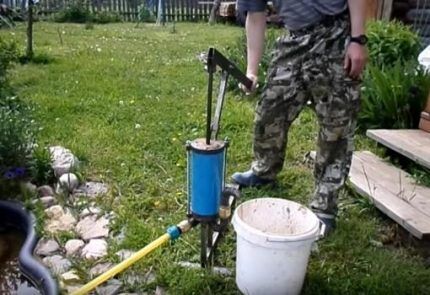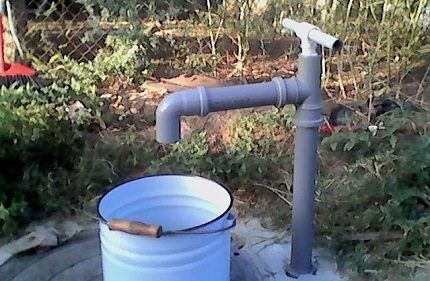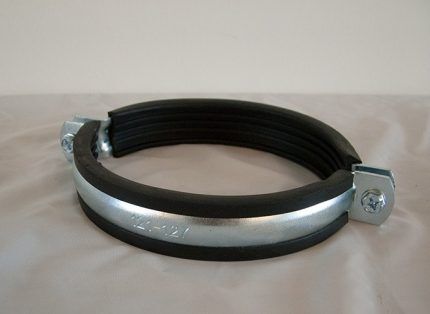Do-it-yourself manual water pump: review of the best homemade products
Pumping water with a hand pump, of course, is not as convenient as its electric counterpart. The speed of work is not even close to comparison.However, there are situations when a hand pump for water is necessary, and sometimes the only possible solution. For example, as a temporary type at the stage of installing water supply at home. It is unwise to buy a device for short-term use. Do you agree?
We offer extensive information on options for making your own hand pumps. We present practice-tested methods available to home craftsmen in terms of costs and methods of implementation. A homemade product created according to our advice will reliably serve its intended duration.
The presented article contains valuable recommendations for craftsmen who want to implement a difficult idea. Popular and less popular models are carefully described. The information is supported by photo collections, diagrams and video tutorials.
The content of the article:
Purpose of manual models
The main purpose of using pump-type equipment is to pump water from a source to certain points: to a residential building, bathhouse, garage, garden. In suburban areas the source is most often wells and wells, less often - ponds and other bodies of water.
All residential or country houses can be divided into three categories: permanent, seasonal and periodic residence. Not all of them have electricity, and some are supplied irregularly.
If we summarize all these factors, we can draw the following conclusions:
- in permanent residences, electricity is used by default, so the main equipment for pumping water is an electric pump, and the manual model is a spare backup unit;
- if the cottage is used only in the summer and power lines are connected, then the energy-dependent option is also ideal, and the manual device plays a secondary role;
- a summer cottage without electricity most of all needs manual equipment.
To irrigate 2-3 flower beds, you can still draw water with buckets, but to ensure complete and daily watering of beds, greenhouses and lawns, a pump is needed. This is where a model that requires a pair of hands to operate comes in handy.
You can make a simple speaker yourself by using the skills of welding and assembling metal or plastic parts.

Some craftsmen build reliable equipment for wells and wells that serves well for years. We present an overview of homemade products, for the manufacture of which scrap materials were used.
Types of devices for pumping water
Physical force alone used to lift water upward is not enough, since the process becomes difficult and labor-intensive. Therefore, mankind has long ago invented many devices that facilitate the rise of liquid from a well or natural reservoir to the surface.
All devices are united by a common operating principle, which is based on the interaction of the valve system.
There are many varieties of hand pumps, but four main types can be distinguished:
- piston;
- rod deep (varieties of piston);
- winged;
- membrane
For manufacturing at home, they usually choose the first type if it is necessary to service a well of shallow depth (3-6 m), or the second if it is necessary to lift water from a well from a depth of 10-12 m.
These models are considered to be the most productive, easy to assemble and install, and reliable. The rest have significant shortcomings, the biggest of which is considered to be insufficient productivity.
It is piston devices that have occupied the main niche among factory manual equipment; they are popular among home craftsmen.
The advantage of piston column pumps is their ease of assembly and installation. All the parts necessary for the manufacture of the body and dynamic parts can be found on the farm or purchased in addition.
And to connect the elements into a single device, home tools are usually enough: a drill, a circular saw, a hacksaw, pliers, and keys. If you need a welding machine, you can rent it or borrow it from your neighbors.
Popular handicraft pumps
To pump water from one place to another, all kinds of hand pumps are used. Their operating principle is based on the simplest laws of physics, according to which water can move through pipes and vessels due to differences in temperature, pressure, height, etc. Let’s find out how devices made by amateur craftsmen operate.
Option #1 - piston apparatus from casing pipe
The homemade product was invented by a master with a specific purpose - for well pumping. However, it turned out to be quite productive, so it was later used for pumping water out of the pond and as a backup pump during a power outage.

All work on cutting steel elements is carried out with an electric circular saw. If you use hand tools, the production will take a long time.
Welding experience is required to connect metal parts. If you are new to this business, we recommend that you familiarize yourself with rules and nuances of welding.
Review of homemade pump parts:
For installation on the ground, a unique base is used - a structure made of metal pipes 20*40 mm and 20*20 mm. Thanks to the long welded pipes, the pump stands firmly in a strictly vertical position.
Option #2 – rod pump for a well
The model, made from a ready-made fire extinguisher body, differs from the previous one in reliability and greater performance.
A homemade “samovar” can be safely installed in a well up to 15 m deep. It does not have to be used constantly, however, in the absence of electricity or for cleaning the well, it will be simply irreplaceable.
The principle of operation is the same: thanks to the vacuum in the zone of movement of the piston, water flows from the well into the pump housing, and from there through the outlet pipe - out into the substituted container.
The device is suitable for servicing a well, borehole, pool, pond or other body of water. It can pump not only clean water, but also dirty liquid with silt, sand and contaminants.
For manufacturing, you will need a tool for cutting and processing metal parts, as well as a welding machine. Let's look at the distinctive features of the model in more detail.
On top, all metal parts are treated with a primer to protect against corrosion, since the pump will be located outside, in the open air.
On top of the primer, it must be coated with metal paint to make the protective layer as durable and airtight as possible.

It is difficult to judge the exact performance of the device; testing is necessary.However, we can say that with one press of the lever, about 2-3 liters of water are pumped, that is, with just 3-4 presses you can fill a bucket.
If the given instructions for assembling a homemade product seemed complicated to you and you do not want to waste time on manufacturing, but you need a pump to pump dirty water, we advise you to take a closer look at ready-made models sold in stores. To make it easier for you to choose the right model, we suggest you familiarize yourself with best drainage pumpspresented on the market.
Option #3 – collapsible model for the summer season
If the well is shallow, an economical and easy-to-use plastic model can handle the delivery of water to the top.

For self-assembly you will need:
- sewer plastic pipes 50 mm - 2 pieces 3 m each;
- mesh filter for mounting on the end of the pipe;
- thin PP pipe 20 mm with thread for attaching a check valve;
- factory-made check valve;
- fastening the handle from a tee 25*20 mm with a soldered thread;
- metal tube for handle;
- fluoroplastic gasket for making a piston;
- clamps with dowels for attaching the pipe to the walls of the well.
The assembly proceeds as follows. First, a fluoroplastic piston is screwed onto a flexible PP pipe with a diameter of 20 mm, through which water will move, and then a check valve.
Insert it into a sewer plastic pipe with a diameter of 50 mm, close it on the side of the check valve with a nozzle with a filter. The result is a “pipe-in-pipe” structure that must be immersed in the well.

A tee is screwed onto the other end of the PP pipe and a handle is inserted into it. To pump water, you need to hold the handle with both hands and move the pipe up/down.
In appearance and in the way the handle moves, the pump resembles a manual analogue for inflating bicycle wheels.
The outer part is supplemented with a spout made from a piece of sewer pipe and two fittings - a tee and a 90º angle. As the handle moves up/down, water pours out of the spout into the container underneath.
One of the advantages of a simple plastic model is that it can be quickly disassembled. With the onset of cold weather, the outer parts are removed, and the PP pipe is simply pulled out. As a result, only one element remains - the sewer pipe, but in the well shaft there is no threat to it.
If you change your mind about making a homemade pump, you can always purchase ready-made equipment in the store. Tips for choosing a pump for a well we brought here.
Less popular manual modifications
In addition to piston models, which have proven themselves well in factory and homemade versions, other devices are also used.
They are less productive, but interesting from the point of view of design and operating principle.
There are factory models that are not practical to make yourself. For example, equipment based on an impeller. Such devices are used in the industrial sector; they are not very convenient for the garden.
In addition, buying a compact metal device that looks like a can twister will cost no more than making it yourself.
None of the considered homemade pump designs suits you? Then we recommend that you look at more options for homemade products, the production of which we have considered in the next article.
Conclusions and useful video on the topic
Before you start making your own hand pump, study the experience of home craftsmen. This will not only help you learn new technologies, but will also help you avoid annoying mistakes.
Diaphragm pump operation:
Hose equipment instructions:
Testing a simple model for $6:
Assembly, modification and installation of a factory product:
A hand water pump is a great helper in a difficult situation. If an accident occurs on the electric main, you will not be left without water: you can pump several buckets from a well with a hand pump.
And to assemble a useful device yourself, you don’t need to study complex technologies or look for special materials - you can find everything in your household.
Have you decided to assemble a homemade water pump from scrap materials? Maybe you would like to clarify some points that are not fully discussed in this material? Ask your questions in the comments block - we will try to help you.
Or maybe you want to supplement our article with clarifications or useful recommendations? Please write to us about this and express your opinion.




He spent his childhood in the private sector - then every second person had a piston pump, made independently. But then people had no choice, they had to somehow turn around. And now it’s quite possible to buy the necessary equipment; it’s not so expensive that you have to dodge and do it yourself. The photo shows that a lot of water flows past in homemade pumps - in our time, with the expected shortage of fresh water, this is an unacceptable waste.
In our climate, talking about wasting water is the height of stupidity! Preserve the forests around the rivers and there will be plenty of water! We don't live in the Sahara!
I agree that now such devices are inexpensive, but in our village there is a homemade one. Made a long time ago, piston, simple. Everyone is happy with it, the water doesn’t seem to flow past much, so why change it? Of course, if they installed it now, they would buy a new one. But if your hands grow from the right place and you have time for such work, why not do it yourself.
I have a centralized water supply at my dacha, but anything can happen, so I also made a well in reserve. I don't use it all the time, so I don't need an electric pump. I installed a simple manual piston pump. Its advantages are obvious - it does not depend on the availability of electricity, it is easy to assemble and use.The downside is that it will not be able to lift water from great depths. But it was enough for me.
Here we have a well for sand and it’s very shallow, I think about eight or nine meters. We decided that there was no point in installing an electric pump, since we needed very little water at the dacha. In general, it is only required for watering. And we go to get drinking water from a spring, which is well equipped and well maintained. So we installed a hand pump, like the one in your material in the photo with a handle.
I live in a village and we don’t have a central water supply, and getting water from a well, especially when you need a lot of it, is a hassle. So I decided to make a hand pump for water. I ordered a well to be drilled, after which I installed a pump and a regular column with a handle. Now it’s easy and convenient to collect water, the water pressure is good, a 10-liter bucket is filled in just a few seconds.
For the piston, you can use not only metal, but also, for example, 10 mm fiberglass. And cheaper and easier to process!
In the picture with the bicycle, which unit is used as the pump itself? (there is something blue and small on the frame below)
I understand that you are interested in the solution of a hand pump that uses centrifugal force. Regarding the unit, under the bicycle, which you asked about, this is actually the centrifugal surface pump itself. Here the rod is driven not by an electric motor, as was originally intended, but by bicycle pedals.
To be honest, this is not the simplest solution, since a lot of things will be needed here:
— old centrifugal surface pump;
- bike;
— a special adapter frame (you will have to cook it yourself).
As you can see, this is not the simplest and most practical solution. The assembled centrifugal surface pump looks like this. And in the photo of the homemade product there is no electric motor.
Hello. You write: “For making at home, they usually choose the first type if it is necessary to service a well of shallow depth (3-6 m), or the second one if it is necessary to lift water from a well from a depth of 10-12 m.” My question is, how can there be a suction height of 10-12 meters if theoretically 1 atmosphere = 10 meters of water column?